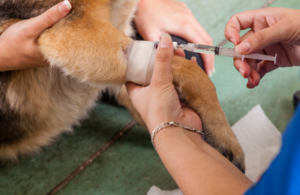Intravenous use of co-amoxiclav products - Adverse events
Awareness and action regarding increase of suspected adverse event reports following use of intravenous co-amoxiclav (amoxicillin and clavulanic acid) products.

News item update
Update provided on 20 September.
We are seeing an increase of suspected adverse event reports following use of intravenous co-amoxiclav (amoxicillin and clavulanic acid) products.
These reports often include anaphylaxis/hypersensitivity signs with a rapid onset, usually within minutes of administration of the product. The most frequently reported signs are urticaria, allergic oedema (often facial/periocular), erythema and pruritus. This can also be accompanied by hypotension and tachycardia.
We are working with the Marketing Authorisation Holders to investigate this finding and are closely monitoring reports.
Report directly to VMD
We strongly encourage anyone who is aware of an adverse event to report directly to us via our online reporting form Report a suspected problem with an animal medicine or microchip
Provide all relevant information, including the batch number.
In addition to continuously monitoring all reports of suspected adverse events (both adverse reactions and lack of efficacy reports) from authorised veterinary medicinal products, we monitor reports of suspected adverse events to human medicines used in animals, such as those containing co-amoxiclav.
The reporting of adverse events is critical to our ongoing monitoring activities in order to protect animal health, public health, and the environment.
Find out more about pharmacovigilance on vmdconnect.uk.
Any human adverse reactions to authorised human medicines should be reported to the Medicines and Healthcare Products Regulatory Agency (MHRA) (Report a problem with a medicine or medical device - GOV.UK (www.gov.uk).
About the products
Authorised human products for intravenous administration containing co-amoxiclav are regularly used in animals via the veterinary medicines cascade.
Co-amoxiclav is used in the treatment of infection and is often used peri-operatively.
Updates to this page
-
Update provided on 20 September.
-
First published.